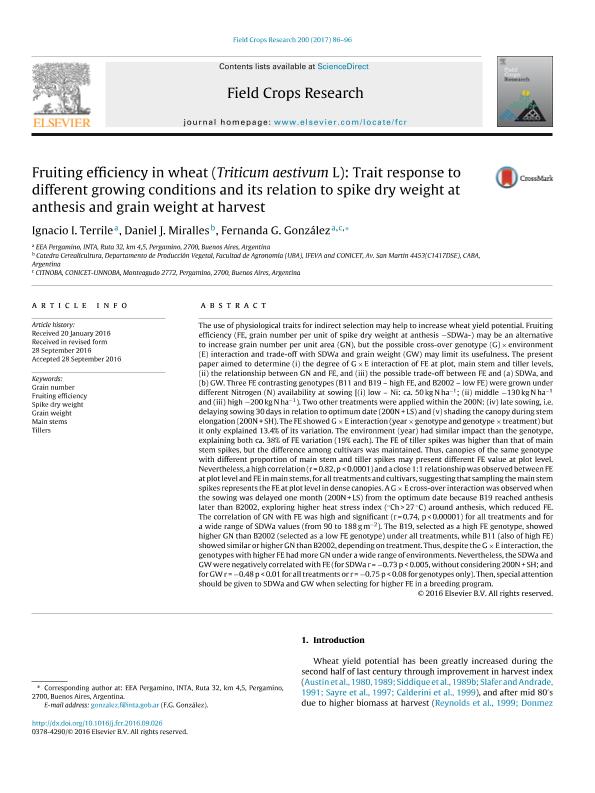Artículo
Fruiting efficiency in wheat (Triticum aestivum L): Trait response to different growing conditions and its relation to spike dry weight at anthesis and grain weight at harvest
Fecha de publicación:
02/2017
Editorial:
Elsevier Science
Revista:
Field Crops Research
ISSN:
0378-4290
Idioma:
Inglés
Tipo de recurso:
Artículo publicado
Clasificación temática:
Resumen
tThe use of physiological traits for indirect selection may help to increase wheat yield potential. Fruitingefficiency (FE, grain number per unit of spike dry weight at anthesis −SDWa-) may be an alternativeto increase grain number per unit area (GN), but the possible cross-over genotype (G) × environment(E) interaction and trade-off with SDWa and grain weight (GW) may limit its usefulness. The presentpaper aimed to determine (i) the degree of G × E interaction of FE at plot, main stem and tiller levels,(ii) the relationship between GN and FE, and (iii) the possible trade-off between FE and (a) SDWa, and(b) GW. Three FE contrasting genotypes (B11 and B19 ? high FE, and B2002 ? low FE) were grown underdifferent Nitrogen (N) availability at sowing [(i) low ? Ni: ca. 50 kg N ha−1; (ii) middle −130 kg N ha−1and (iii) high −200 kg N ha−1). Two other treatments were applied within the 200N: (iv) late sowing, i.e.delaying sowing 30 days in relation to optimum date (200N + LS) and (v) shading the canopy during stemelongation (200N + SH). The FE showed G × E interaction (year × genotype and genotype × treatment) butit only explained 13.4% of its variation. The environment (year) had similar impact than the genotype,explaining both ca. 38% of FE variation (19% each). The FE of tiller spikes was higher than that of mainstem spikes, but the difference among cultivars was maintained. Thus, canopies of the same genotypewith different proportion of main stem and tiller spikes may present different FE value at plot level.Nevertheless, a high correlation (r = 0.82, p < 0.0001) and a close 1:1 relationship was observed between FEat plot level and FE in main stems, for all treatments and cultivars, suggesting that sampling the main stemspikes represents the FE at plot level in dense canopies. A G × E cross-over interaction was observed whenthe sowing was delayed one month (200N + LS) from the optimum date because B19 reached anthesislater than B2002, exploring higher heat stress index (◦Ch > 27◦C) around anthesis, which reduced FE.The correlation of GN with FE was high and significant (r = 0.74, p < 0.00001) for all treatments and fora wide range of SDWa values (from 90 to 188 g m−2). The B19, selected as a high FE genotype, showedhigher GN than B2002 (selected as a low FE genotype) under all treatments, while B11 (also of high FE)showed similar or higher GN than B2002, depending on treatment. Thus, despite the G × E interaction, thegenotypes with higher FE had more GN under a wide range of environments. Nevertheless, the SDWa andGW were negatively correlated with FE (for SDWa r = −0.73 p < 0.005, without considering 200N + SH; andfor GW r = −0.48 p < 0.01 for all treatments or r = −0.75 p < 0.08 for genotypes only). Then, special attentionshould be given to SDWa and GW when selecting for higher FE in a breeding program.
Palabras clave:
Grain Number
,
Fruiting Efficiency
,
Spike Dry Weight
,
Main Stems And Tillers
Archivos asociados
Licencia
Identificadores
Colecciones
Articulos(IFEVA)
Articulos de INST.D/INV.FISIOLOGICAS Y ECO.VINCULADAS A L/AGRIC
Articulos de INST.D/INV.FISIOLOGICAS Y ECO.VINCULADAS A L/AGRIC
Articulos(SEDE CENTRAL)
Articulos de SEDE CENTRAL
Articulos de SEDE CENTRAL
Citación
Terrile, Ignacio Ismael; Miralles, Daniel Julio; González, Fernanda Gabriela; Fruiting efficiency in wheat (Triticum aestivum L): Trait response to different growing conditions and its relation to spike dry weight at anthesis and grain weight at harvest; Elsevier Science; Field Crops Research; 203; 2-2017; 86-96
Compartir
Altmétricas




